Sam Hughes of The Sound Architect visited the fantastic Develop in Brighton Conference 8-10th July 2014.
For those of you unaware of Develop it is a fantastic conference between gaming professionals of all areas, where there is a fantastic array of talks to go to as well as great exhibits to see. In this case the at the expo developers were displaying new games and gear as well as advertising positions in their companies.
Sam recounts his trip below:
Introduction
Develop in Brighton was a fantastic 3 day event and even though you’re all probably most bothered about the audio day I highly suggest you try to go for the others too. There were some very interesting talks and I met some very interesting people.
Besides, as we’re always saying it’s good for people to know our job so that production workflow is better, so why shouldn’t we learn a bit about everyone else’s part of the process?
Tuesday – Evolve
I arrived on the Tuesday and sadly missed all of the Evolve talks on the first day. I was however looking forward to most of them, especially the Unity talk and social psychology talks.
However I did make it to the icebreaker drinks where I connected with some great people. These included students, volunteers, people in the industry and people wanting to enter the industry. I highly recommend attending, as you will definitely meet some great individuals who are all passionate in some way about the games industry.
Wednesday – Develop
The Wednesday kicked of at 10am with the interesting Develop keynote from Andrew House and Mark Cerny.
Andrew House has been President and Group Chief Executive Officer of Sony Computer Entertainment Inc. (SCEI) since September 2011. Working closely with Sony Corporation’s senior management, as well as business units and regional management teams, he is responsible for the development and growth of the PlayStation business globally.
Mark Cerny is known both for the success of the titles to which he has contributed, and the variety of roles that he has performed on them. During a career spanning over thirty years, Mark has worked as game designer, programmer, producer, and director in arcade games and console games in the U.S. and Japan.Mark was also the lead system architect on Sony’s PlayStation 4 console.
This keynote was a fantastic talk recounting the history of the Playstation and how it has progressed over the years to become the new Playstation 4 design.
It was great after growing up with the Playstation to understand it’s origins and learn how the process works when creating a console.
However I digress. The audio day was not until the Thursday so Wednesday was a fantastic opportunity for more networking and absorbing of information. There are always many that are going on and I suggest as a sound designer, composer, voice actor or whatever your talents, you try to go to as many as you can.
There was also Project Morpheus on display! It was fantastic to get a go. It was however slightly uncomfortable on my face but as it was only a ten minute slot I can’t say I had ample time to adjust properly. After trying out The Deep I can say that I very much look forward to trying it out more. The sound is pretty cool from what I’ve heard with great immersion as you look around. If you can get a go, please do and let me know your thoughts!
There was also an audio meetup arranged on the Wednesday evening, as there are at many events around the country. Keep an eye out for the hashtag #gameaudio and game audio in general if you weren’t already aware of these, many of us audiophiles are open to meeting up with other audio folk, myself included!
It’s a great chance to talk shop as well as understand more and more about the industry.
Thursday – THE AUDIO TRACK!
Right now the moment you’ve probably skipped ahead to, the Audio Track!
Thursday 10th was the audio day full of insightful and fantastic talks.
The opening introduction from John Broomhall led us into Wayne Johnson’s talk on the new audio features in Unity 5.
Unity 5 Audio Showcase – Wayne Johnson – Unity
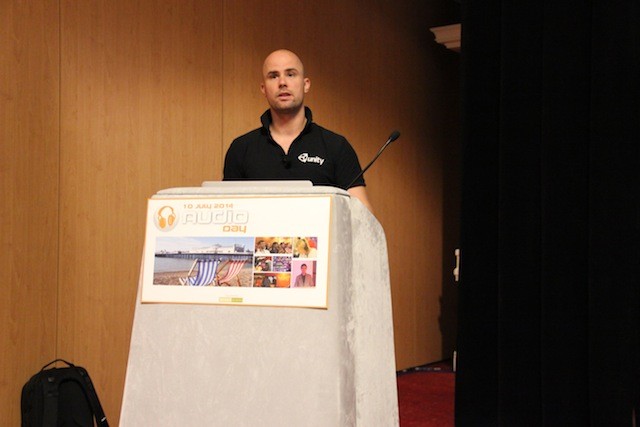
I have to admit I haven’t used Unity that much myself, but I have been hearing about the lack of great audio support. Withe new mixer you can group sounds within a hierarchy, meaning you can modify whole categories at once.
There are a variety of effects and processes now available including ducking, custom DSP effects, synths etc. The effects that I saw were basic reverb and echo, which are still quite versatile but I can tell there’s a lot of room for improvement in the future.
The snapshot feature is interesting, where it’s similar to most other software and basically saves a preset of your sound settings. This was demonstrated in a situation where you can allocate snapshots to areas of the world, in the case of the presentation a snapshot was saved to a building. This meant that when entering the room, different effects and attenuation was applied to the sounds in the scene.
There was also a synth example used where the snapshot would change the music depending on whether the character was running or not.
The other highlights mentioned were; the fact that sounds are now packed in propriety soundbanks, you can encode and decode any size files and that overall it optimises workflow when inserting audio into your game.
The Future is Now – but Now What? – Scott Selfon – Xbox Advanced Technology Group (ATG)
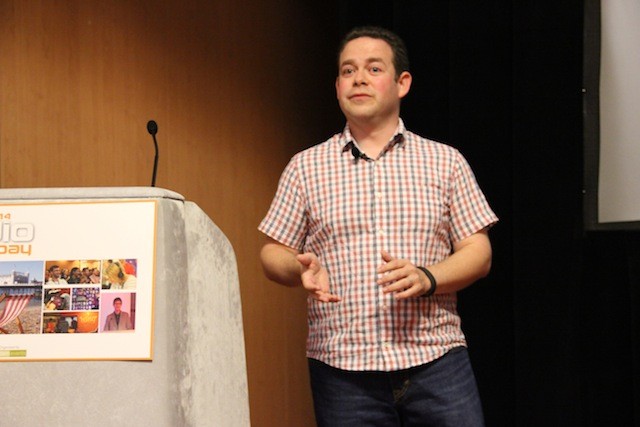
After the coffee break Scott’s talk focused on the future of game audio and what our next steps might be. His key point was that the future is Awareness.
Firstly Scott mentions the awareness of Music, making it more responsive and intuitive. He used an old Bug’s Bunny cartoon to demonstrate his point how the music was based on the characters actions. This is an interesting point that I have often thought myself. We are getting there with many examples becoming more and more apparent.
One of the most recent examples that Scott himself demonstrated was with Peggle 2 on the Xbox One. The music changes the closer you get to clearing the pegs and becomes more dramatic, reacting to the user interaction. This is common in arcade type games but I agree with Scott in the fact that this is an area where we can continue to pursue advancement.
Scott’s second point was awareness of the Environment, meaning more accurate reinforcement of detailed realism. Taking into account every detail significantly such as proper sound propagation with regards to distance. Realising everything such as temperature, humidity and air flow. All of the things that affect how we perceive sound.
Then awareness of Soundscape. Sounds can now feedback into the game. Dead Rising 3‘s utilisation of the Kinect’s mic to shout at zombies was demonstrated as an example of this. I think this is a great concept to pursue. When I first experienced it in DR3 I began to consider the possibilities for the future. Games reactions based on our surroundings maybe? Horror games that pick up on the ambient sound in the room? There are so many possibilities with all this new technology and it’s such an exciting era to be involved in.
Another concept related to the soundscape is how the physical or graphical elements in a game can be controlled by the audio instead of the other way round. The example presented here was in Tom Clancy’s Ghost Recon: Advanced Warfighter 2. In this scene the sound of the wind drove the visuals of the smoke. The louder/more intense the wind the more the smoke would billow. Again, endless possibilities in reverse engineering the visuals to rely on the sound instead of the other way round.
The newest SSX is another great example used where the landing of a special trick is slowed down to make sure that the landing coincides with the “on” beat of the music.
Scott ends with mentioning how we can have more detauled dialogue that is more reactive and has many more options. Mentioning the quiz game “You don’t know Jack”, which has a number of dialogue responses based on user input, date/time. He discusses how we should think about this more, for example having high and low intensity versions of lines.
Overall Scott mentions that we need to be have More. More realistic, with more surprises with more personalised experiences and game audio that is more self aware.
Penny Drops and Paper Cuts – Kenny Young – Media Molecule Head of Audio
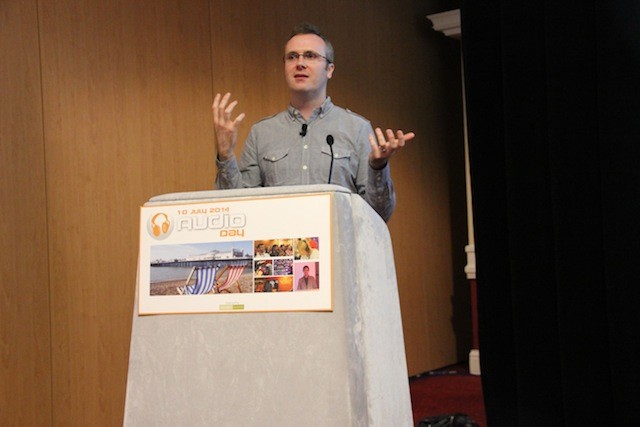
Kenny’s very amusing talk began by expressing a very valid point. He discusse how after leaving University he worked on projects and made decisions he wasn’t happy with, with respect to the audio, and that he is still bugged today by them. However, he realised that only he was in control of that side of things, that we shouldn’t rely on grades from lectures to tell us how good our audio is. That you have to “step up and be your own assessor”.
Don’t lose sight of the end game, he goes on to say and that no matter where you get in the project always keep the final goal in sight in your mind. Kenny goes on to discuss how the initial voices in our head (the instincts we have about our work that is!) are usually right, and that we should listen to them rather than ignore them.
We have to realise that just because you’re really into something, it doesn’t mean it’s appropriate for the game you’re working on.
Don’t sweep stuff under the carpet, make sure you assess as you go along as well as respect the sound of other people voices too. They may not always know what they’re trying to say but they usually can detect a problem so reverse engineer and find out what it is.
Kenny also mentioned how a problem with the audio may not always be the audio itself. It could be a game mechanic that needs fixing, so it’s worth looking into and understanding.
I spoke to Kenny briefly about his perspective on game audio:
AAA Tablet & Mobile Audio
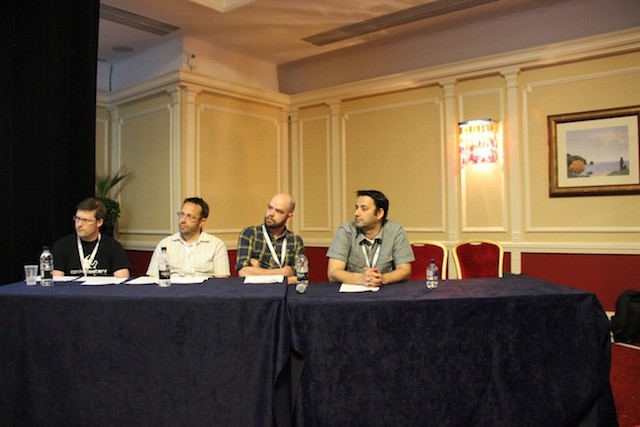
John Broomhall (Chair). Anastasios Brakis – Studio Gob, Jethro Dunn- Codemasters, Daan Hendriks – Mind Candy, Stafford Bawler – Freelance
This was a very interesting panel chaired by John Broomhall, as I never really think to much about mobile games and their audio. It was a good insight into the world of mobile gaming.
I’ll briefly cover the topics discussed:
One of the biggest challenges that was agreed on was to make sure the audio is considered and important part of the process.
They all discussed how they mix in headphones and reference on speakers, due to the fact that it makes sense to mix for what the consumer is most likely to use.
The future was considered to be different types of games with shorter experiences, but also include the ability to use more powerful techniques.
I caught Jethro Dunn for a quick chat about his view on mobile game audio and game audio:
Total Immersion: Music and Sound in The Chinese Room – Jessica Curry & Dan Pinchbeck
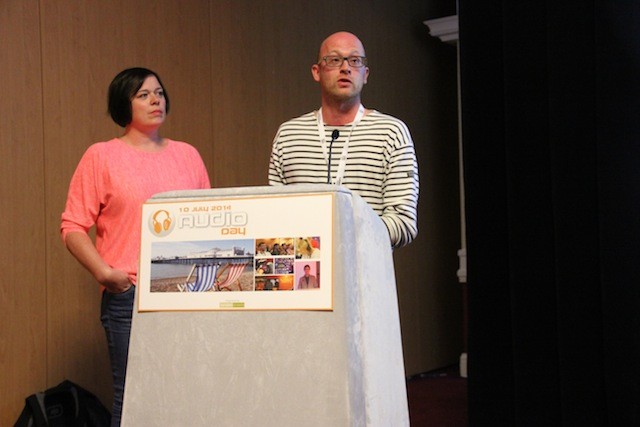
Another amusing and insightful talk, where you can tell how passionate Jessica & Dan are with the audio side of projects.
Jessica discussed how important it is to fight your corner as much as you can to ensure that you have the highest quality audio in the project. Don’t underestimate the difference between samples and recording live musicians for your music.
Always explain the impact great audio will have on their game and how much difference it will make with excellent audio quality.
Right Place, Right Time: Telling Micro-stories With Sound – Steve Brown – Lionhead
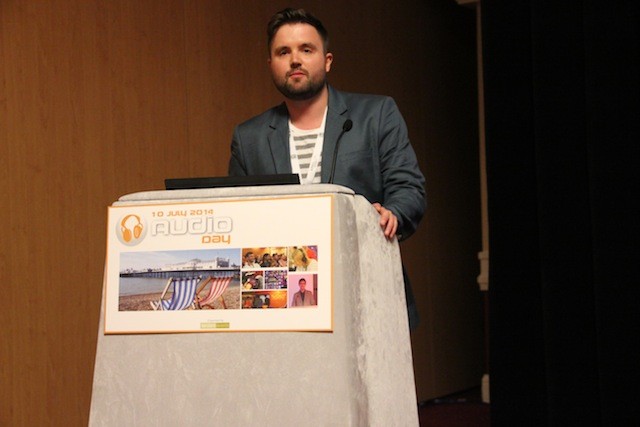
Steve Brown expressed the importance of telling “micro-stories” with your audio. As sound designers we are story-tellers. Looking at what sounds are required and what the story is.
Telling lots of micro-stories to make your story means a very high level of attention to detail.
Leading on from this Steve showed us great insights into the amount of detail used in Fable: The Journey, specifically on the cart. Showing us the Wwise project really demonstrated the attention to detail they had when creating the sound design for this “character” as the cart became. This involved a 3D sound emitter with over 300 custom recorded assets! There was an extreme amount of Foley and therefore number of tracks, I do NOT envy the editing process of this one!.
They also focused on the horse as a character in the story, spending time making sure there was an emotional reaction in it’s responses to the whip cracks.
He then went on to discuss how vital the dialogue is in game audio, referencing The Last of Us and Skeleseer for micro-stories.
Audio Keynote – Past, Present & Future of Game Audio – Garry Taylor – Audio Director for Sony Worldwide Studios’ Creative Services Group
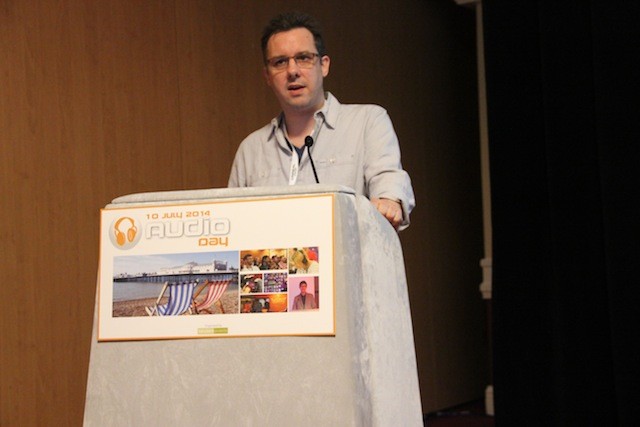
In the keynote Garry discussed how Project Morpheus was developed and how games are influencing atmos more than atmos influencing games.
He also discussed how headphones are becoming more and more common in the gaming world, even with console gaming at home. Just because the audio is easier to get higher quality as opposed to using surround sound gear.
With Project Morpheus he breifly discussed how 3D audio libraries are used, based on HRTF and interaural delays for virtual speakers.
Open Mic – Steve Brown, Lionhead Studios; Kenny Young, Media Molecule; Scott Selfon, Xbox ATG; Tim Bartlett, The Audio Guys; Jethro Dunn, Codemasters; and Garry Taylor, Sony Computer Entertainment
The open mic was a fitting talk to end the day where general game audio topics were discussed with questions from across the board with great interaction from the audience. It was fantastic to see how passionate everyone was throughout the room.
I think you’ve probably read enough by now so I’ll sum it up!
Summary
Overall I learnt even more than I expected to in the first place and met so many people I’ve lost count! I have opened my mind to even more concepts and after speaking with people from all areas of game development it has cause me to think of working with game audio in various different ways.
Thanks for reading I hope you enjoyed the article, and look forward to seeing you at the next Develop! If you have any comments or questions feel free to contact me on Twitter, leave a comment below or e-mail!
For more information check out the links below:
AUTHOR:
Sam Hughes: @samhughes88
SPEAKERS on Twitter:
John Broomhall – @JohnBroomhall
Wayne Johnson – @wkajohnson
Scott Selfon – @selfon
Kenny Young – @kcmyoung
Daan Hendriks – @Audiodaan
Stafford Bawler – @StaffordBawler
Garry Taylor – @Tetley_Uk
Jessica Curry – @jessicacurry2
Dan Pinchbeck – @danpinchbeck
Steve Brown – @SteveBrownSound
Enjoy!
The Sound Architect
Photos from: audiomedia.com/events/0008/gallery-develop-conference-audio-day/1245
Article by Sam Hughes
Uploaded 26/07/14


